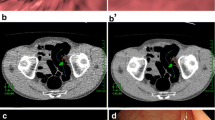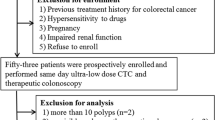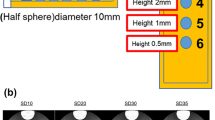Abstract
Objective
To prospectively compare reduced-dose (RD) CT colonography (CTC) with standard-dose (SD) imaging using several reconstruction algorithms.
Methods
Following SD supine CTC, 40 patients (mean age, 57.3 years; 17 M/23 F; mean BMI, 27.2) underwent an additional RD supine examination (targeted dose reduction, 70–90 %). DLP, CTDIvol, effective dose, and SSDE were compared. Several reconstruction algorithms were applied to RD series. SD-FBP served as reference standard. Objective image noise, subjective image quality and polyp conspicuity were assessed.
Results
Mean CTDIvol and effective dose for RD series was 0.89 mGy (median 0.65) and 0.6 mSv (median 0.44), compared with 3.8 mGy (median 3.1) and 2.8 mSv (median 2.3) for SD series, respectively. Mean dose reduction was 78 %. Mean image noise was significantly reduced on RD-PICCS (24.3 ± 19HU) and RD-MBIR (19 ± 18HU) compared with RD-FBP (90 ± 33), RD-ASIR (72 ± 27) and SD-FBP (47 ± 14 HU). 2D image quality score was higher with RD-PICCS, RD-MBIR, and SD-FBP (2.7 ± 0.4/2.8 ± 0.4/2.9 ± 0.6) compared with RD-FBP (1.5 ± 0.4) and RD-ASIR (1.8 ± 0.44). A similar trend was seen with 3D image quality scores. Polyp conspicuity scores were similar between SD-FBP/RD-PICCS/RD-MBIR (3.5 ± 0.6/3.2 ± 0.8/3.3 ± 0.6).
Conclusion
Sub-milliSievert CTC performed with iterative reconstruction techniques demonstrate decreased image quality compared to SD, but improved image quality compared to RD images reconstructed with FBP.
Key points
• CT colonography dose can be substantially lowered using advanced iterative reconstruction techniques.
• Iterative reconstruction techniques (MBIR/PICCS) reduce image noise and improve image quality.
• The PICCS/MBIR-reconstructed, reduced-dose series shows decreased 2D/3D image quality compared to the standard-dose series.
• Polyp conspicuity was similar on standard-dose images compared to reduced-dose images reconstructed with MBIR/PICCS.











Similar content being viewed by others
References
Siegel R, Naishadham D, Jemal A (2012) Cancer statistics, 2012. CA Cancer J Clin 62:10–29
Society AC (2011) Colorectal cancer facts and figures 2011–2013.
Pickhardt PJ, Choi JR, Hwang I et al (2003) Computed tomographic virtual colonoscopy to screen for colorectal neoplasia in asymptomatic adults. N Engl J Med 349:2191–2200
Johnson CD, Chen MH, Toledano AY et al (2008) Accuracy of CT colonography for detection of large adenomas and cancers. N Engl J Med 359:1207–1217
Graser A, Stieber P, Nagel D et al (2009) Comparison of CT colonography, colonoscopy, sigmoidoscopy and faecal occult blood tests for the detection of advanced adenoma in an average risk population. Gut 58:241–248
Brenner DJ, Hall EJ (2007) Computed tomography–an increasing source of radiation exposure. N Engl J Med 357:2277–2284
Boellaard TN, Venema HW, Streekstra GJ, Stoker J (2012) Effective radiation dose in CT colonography: is there a downward trend? Acad Radiol 19:1127–1133
Berrington de Gonzalez A, Kim KP, Knudsen AB et al (2011) Radiation-related cancer risks from CT colonography screening: a risk-benefit analysis. AJR Am J Roentgenol 196:816–823
Brenner DJ, Georgsson MA (2005) Mass screening with CT colonography: should the radiation exposure be of concern? Gastroenterology 129:328–337
Chang KJ, Yee J (2013) Dose reduction methods for CT colonography. Abdom Imaging 38:224–232
Ginsburg M, Obara P, Wise L, Wroblewski K, Vannier MW, Dachman AH (2013) BMI-based radiation dose reduction in CT colonography. Acad Radiol 20:486–492
Graser A, Wintersperger BJ, Suess C, Reiser MF, Becker CR (2006) Dose reduction and image quality in MDCT colonography using tube current modulation. AJR Am J Roentgenol 187:695–701
Iannaccone R, Laghi A, Catalano C, Mangiapane F, Piacentini F, Passariello R (2003) Feasibility of ultra-low-dose multislice CT colonography for the detection of colorectal lesions: preliminary experience. Eur Radiol 13:1297–1302
Fisichella VA, Bath M, Allansdotter Johnsson A et al (2010) Evaluation of image quality and lesion perception by human readers on 3D CT colonography: comparison of standard and low radiation dose. Eur Radiol 20:630–639
van Gelder RE, Venema HW, Florie J et al (2004) CT colonography: feasibility of substantial dose reduction–comparison of medium to very low doses in identical patients. Radiology 232:611–620
Chang KJ, Caovan DB, Grand DJ, Huda W, Mayo-Smith WW (2013) Reducing radiation dose at CT colonography: decreasing tube voltage to 100 kVp. Radiology 266:791–800
Gryspeerdt SS, Salazar P, Lefere P (2014) Image quality improvement in submillisievert computed tomographic colonography using a fast 3-dimensional noise reduction method. J Comput Assist Tomogr. doi:10.1097/rct.0000000000000092
Lambert L, Danes J, Jahoda J, Masek M, Lisy J, Ourednicek P (2014) Submilisievert ultralow-dose CT colonography using iterative reconstruction technique: a feasibility study. Acta Radiol. doi:10.1177/0284185114533683
Flicek KT, Hara AK, Silva AC, Wu Q, Peter MB, Johnson CD (2010) Reducing the radiation dose for CT colonography using adaptive statistical iterative reconstruction: A pilot study. AJR Am J Roentgenol 195:126–131
Yoon MA, Kim SH, Lee JM et al (2012) Adaptive statistical iterative reconstruction and Veo: assessment of image quality and diagnostic performance in CT colonography at various radiation doses. J Comput Assist Tomogr 36:596–601
Lubner MG, Pickhardt PJ, Tang J, Chen GH (2011) Reduced image noise at low-dose multidetector CT of the abdomen with prior image constrained compressed sensing algorithm. Radiology 260:248–256
McCollough C, Cody D, Edyvean S et al. (2008) The measurement, reporting and mangement of radiation dose in CT. American Association of Physicists in Medicine. AAPM, College Park, MD
Deak PD, Smal Y, Kalender WA (2010) Multisection CT protocols: sex- and age-specific conversion factors used to determine effective dose from dose-length product. Radiology 257:158–166
Boone JM, Strauss KJ, Cody DD, McCullough CH, McNitt-Gray MF, Toth TL (2011) Size-Specific Dose Estimates (SSDE) in Pediatric and Adult Body CT ExaminationsAmerican Association of Physicists in Medicine. American Association of Physicists in Medicine, College Park MD
Bankier AA, Kressel HY (2012) Through the Looking Glass revisited: the need for more meaning and less drama in the reporting of dose and dose reduction in CT. Radiology 265:4–8
Lubner MG PP, Kim DH, Tang J, Munoz del Rio A, Chen GH (2014) Prospective Evaluation of Prior Image Constrained Compressed Sensing (PICCS) Algorithm in Abdominal CT: A comparison of reduced dose with standard dose imaging. Abdom Imaging In Press
Sagara Y, Hara AK, Pavlicek W, Silva AC, Paden RG, Wu Q (2010) Abdominal CT: comparison of low-dose CT with adaptive statistical iterative reconstruction and routine-dose CT with filtered back projection in 53 patients. AJR Am J Roentgenol 195:713–719
Prakash P, Kalra MK, Kambadakone AK et al (2010) Reducing abdominal CT radiation dose with adaptive statistical iterative reconstruction technique. Invest Radiol 45:202–210
Tang J T-LP, Chen G.-H. (2011) Proc. SPIE 7961, Medical Imaging. Physics of Medical Imaging. 10.1117/12.878200
Chen GH, Tang J, Leng S (2008) Prior image constrained compressed sensing (PICCS): a method to accurately reconstruct dynamic CT images from highly undersampled projection data sets. Med Phys 35:660–663
Pinheiro JC, Bates DM (2000) Mixed-effects models in S and S-PLUS. Springer, New York
Bland JM, Altman DG (2007) Agreement between methods of measurement with multiple observations per individual. J Biopharm Stat 17:571–582
Team RDC (2013) R: A language and environment for statistical computing R Foundation for Statistical Computing, Vienna, Austria, http://www.R-project.org
Pickhardt PJ, Lee AD, Taylor AJ et al (2007) Primary 2D versus primary 3D polyp detection at screening CT colonography. AJR Am J Roentgenol 189:1451–1456
Pickhardt PJ, Lubner MG, Kim DH et al (2012) Abdominal CT with model-based iterative reconstruction (MBIR): initial results of a prospective trial comparing ultralow-dose with standard-dose imaging. AJR Am J Roentgenol 199:1266–1274
Acknowledgements
The scientific guarantor of this publication is the first author, Dr. Meghan G. Lubner. The authors of this manuscript declare financial relationships as detailed below:
M. Lubner: Grant funding GE Medical (GE-AUR Radiology Research Academic Fellowship, GERRAF)
B. Dustin Pooler, Doug Kitchin, Ke Li: None
Jie Tang: Now an employee of GE Medical
David H. Kim: Consultant, Viatronix, Inc; Co-founder VirtuoCTC, LLC; Medical Advisory Board, Digital Artforms, Inc.
Guanghong Chen: Research funding from GE, Siemens AG, Hologic
Perry J. Pickhardt: Consultant, Check-Cap Ltd; Consultant, Viatronix; Consultant, Mindways; Consultant, Braintree; Co-founder of VirtuoCTC, LLC
This work was partially supported by the Society of Abdominal Radiology Howard S. Stern Research award and National Institute of Health (NIH) grant funding R01CA169331.
One of the authors, Dr. Alejandro Munoz del Rio, has significant statistical expertise.
Institutional review board approval was obtained, and written informed consent was obtained from all subjects in this study.
This is an ongoing prospective trial, so a portion of this cohort was previously reported in a manuscript describing preliminary results of the entire cohort, published in AJR and a manuscript accepted for publication in Abdominal Imaging:
Lubner MG, Pickhardt PJ, Kim DH, Tang J, Del Rio AM, Chen GH. Prospective Evaluation of prior image constrained compressed sensing (PICCS) algorithm in abdominal CT: a comparison of reduced dose with standard dose imaging. Abdom Imaging 2014 Jun 19, epub ahead of print.
Pooler BD, Lubner MG, Kim DH, Ryckman EM, Sivalingam S, Tang J, Nakada SY, Chen GH, Pickhardt PJ. Prospective Trial for the Detection of Urolithiasis at Ultra-low-dose (Sub-mSV) Non-contrast CT: Direct Comparison against Routine Low-dose Reference Standard. J Urol 2014 May 21, epub ahead of print.
Pickhardt PJ, Lubner MG, Kim DH, Tang J, Ruma JA, del Rio AM, Chen GH. Abdominal CT with model-based interative Reconstruction (MBIR): initial results of a prospective trial comparing ultralow-dose with standard-dose imaging. AJR 2012; 199 (3): 1266–74.
This is a prospective case–control or case-matched study performed at one institution.
Author information
Authors and Affiliations
Corresponding author
Additional information
This work was presented as an oral presentation at the Society of Abdominal Radiology meeting in March 2014.
Appendix 1
Appendix 1
Rights and permissions
About this article
Cite this article
Lubner, M.G., Pooler, B.D., Kitchin, D.R. et al. Sub-milliSievert (sub-mSv) CT colonography: a prospective comparison of image quality and polyp conspicuity at reduced-dose versus standard-dose imaging. Eur Radiol 25, 2089–2102 (2015). https://doi.org/10.1007/s00330-015-3603-9
Received:
Revised:
Accepted:
Published:
Issue Date:
DOI: https://doi.org/10.1007/s00330-015-3603-9




